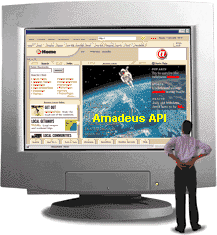

 |

Product Overview |
| Table of Contents |
|---|
| Amadeus API |
|---|
|
The Amadeus API is a development tool that enables a company to program customized client applications that interface to the Amadeus Global Distribution System.
|
|
|
| KEY FEATURES AND BENEFITS |
|---|
|
The Amadeus API is not a 'ready-to-use' product, but requires software development on the client side. The API package is therefore a 'toolkit' for client developers on which to build their own application. It is easy to set up on the customer side, requiring the support of industry standard communication protocols and off-the-shelf software. It is stable. The client package will be compatible with future versions of the Amadeus API software. It offers a straightforward programming environment for software developers and is easy to install and use. It eliminates the need for screen parsing by providing the client application with structured data. It is safe to use because of secure internet communication protocols. A built-in online remote trace facility is provided for easier problem recognition and resolution. The API is available on: supported platforms The Developer Assistance Program team (DAP) is available to help with all API questions. |
|
|
| TECHNICAL CHARACTERISTICS |
|---|
|
The Amadeus API works with a Multi-Tier Architecture(
Local User
or
Server
Implementation ).
|

|
|
|